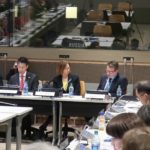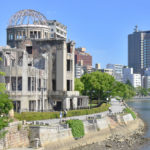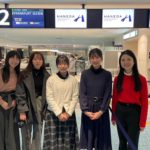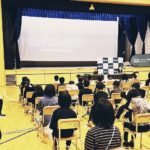5 Class Research Promotion and Regularization of PTA Activities
By 1950, 5 years after the end of the war, social infrastructure and regulations were developing slowly but surely. In fact, on August 8th, 1949, the Hiroshima Peace Memorial City Construction Law was issued, promoting a new construction project begun in Hiroshima. The Hiroshima Prefectural Board of Education was established on December 1st, 1950, in order to set a new trajectory in educational administration and improve education in Hiroshima, with the guiding principal that education was to be the foundation of a new, “International Peace City” 64). This system was newly established after the war. In contrast to the centralized and bureaucratic educational administration before the war, it made the educational administration independent from the general administration in order to reflect the actual status and public opinions of each area. The Hiroshima Prefectural Board of Education set the Targets for Hiroshima City Education as a new fiscal year started in 1951. The following three points were mentioned as its goals: 1) Promotion of moral education, 2) thoroughness of health education, and 3) promotion of production education. All the faculty members of Hiroshima municipal elementary, junior high school and high school worked together in an effort to embody these goals and achieve them65). In addition, as core schools of this research practice, a total of six research designated schools were assigned to each target, one elementary school and one junior high school for each target. Furthermore, “Experimental study of revised guidelines,” “Dowa Education,” “Audiovisual education,” and “Special Education Activities” were designated as important tasks promoting education in Hiroshima City and particular schools were assigned to conduct research on and study each task. Then, Honkawa Elementary School was designated the experimental school of “Special Education Activity”. Each designated school developed research in close collaboration with the Board of Education over three years and disseminated the results to other schools by publishing at research presentation conferences66). This mechanism of Lesson Study67) rooted in the steady practice of the educational institutes made a great contribution to improving the quality of Japanese education after the war.
Meanwhile, the institutionalization of school support from the local community advanced gradually. In other words, the activities of the Parents’ Association and PTA, which had made efforts to repair schools and construct new school buildings in order to improve the educational environment, developed their activities as organizations supporting school education in various ways. In fact, Honkawa Elementary School launched “Honkawa PT,” the PTA Bulletin, on July 20th, 1953. The first issue consists of four pages in double-sided printing on B4-size paper. Headlines of articles were Messages from the Principal, Editorials: Human Value, On Publication (by the Chairperson of PTA), School Event Calendar, School Activities: a Visit to Areas Damaged by the Flood (Children’s Association), Children’s Morning Meeting, Study in the Comfortable Library, Where Peace Education is Born: Peace Education Material Room Installed in Our School, Revival of Mottainai, Cheerful City, Tanka: Scolding Children, Expansion of the School Building, Voice (Column), Fiscal Year 1953 PTA Officer List , Fiscal Year 1953 PTA Budget, Advertiser Recruitment and advertisements from seven local companies. The Message from the Principal read “…nearly thirty faculty members worked together to continue to make improvements on a daily basis through research, practice and reflection on topics ranging from fundamental educational problems to practical teaching. We have made substantial efforts to establish school feature as a representative school in Hiroshima. Hence, we have reached a satisfactory condition” 68). This statement shows how school education, having started from scratch, was finally getting on track. On top of this, the principal explained the significance of the PTA: “…The PTA’s task is to raise members’ cultural level and promote the happiness of children. Creating an environment where children can become sound both physically and mentally is an essential role of the PTA’s. Since our school is still facing many problems with our facilities, we hope for your further support in the future and conclude with a salutation” 69). In addition, the PTA chairperson commented in his message; “…We hope that our modest support improves the welfare of the children by helping to strengthen their ties to each other and serving as an institute that helps closer communication between the school and households… 70) ” This also suggests that the PTA played an important role in school-home communication. After that, the second issue of the PTA bulletin was published on January 1st, 195471), and the third on March 25th72). Specifically, the PTA bulletins were published at the end of every third semester. For example, before summer vacation started, an article entitled “Guidance for Summer Vacation: for Parents” appeared explaining the following three points as requests to home: 1) healthy life (sunburn, food and sleep), 2) Safe life (being careful about accidents at sea and in rivers), and 3) educational guidance (considering children’s independence) 73).
In this way, school support from the local community, centered around the PTA, was revitalized, leading to mutual communication between the school and the local community and gathering local people to the school. As a result, the school contributed to community development as a center of the area. This virtuous circle truly drove the reconstruction of education in Hiroshima.
64)Hiroshima City Board of Education(1981), “Kyouikuiinkai Seido no Gaikan”(Overview of Board of Education System), In Hiroshima Kyouiku Iinkai 30 nen no Ayumi, (30 year History of Hiroshima City Board of Education),p.2
65)Ibid.,p.9
66)Ibid.,p.9
67)National Association for the Study of Educational Methods(2009), Nihon no Jugyou Kenkyu:Jou Gekan, (Class Study in Japan: First and Second Vol.), Gakubunsha
68)Honkawa Elementary School PTA (July 20th,1953) Honkawaw PTA: Soukango, (Honkawa PTA: First Issue), Honkawa PTA, p.1
69)Ibid.,p.1
70)Ibid.,p.1
71)Honkawa Elementary School PTA (January 1st,1954) Honkawaw PTA: Dainigo, (Honkawa PTA: Second Issue), Honkawa PTA
72)Honkawa Elementary School PTA (March 25,1954) Honkawaw PTA: Daisango, (Honkawa PTA: Third Issue), Honkawa PTA
73)Honkawa Elementary School PTA (July 20th,1954) Honkawaw PTA: Daiyongo, (Honkawa PTA: FourthIssue), Honkawa PTA,p.5
Tags associated with this article








